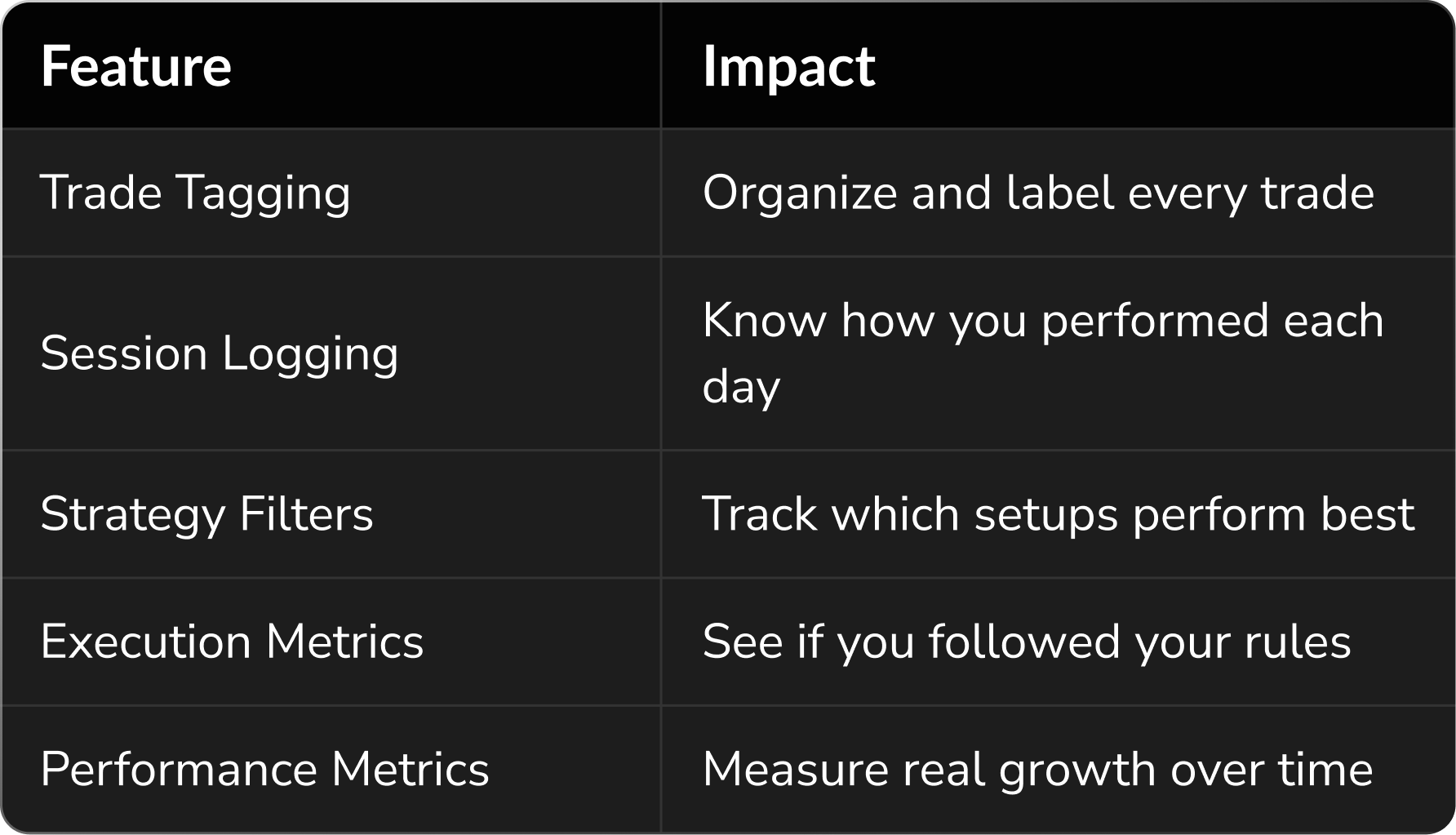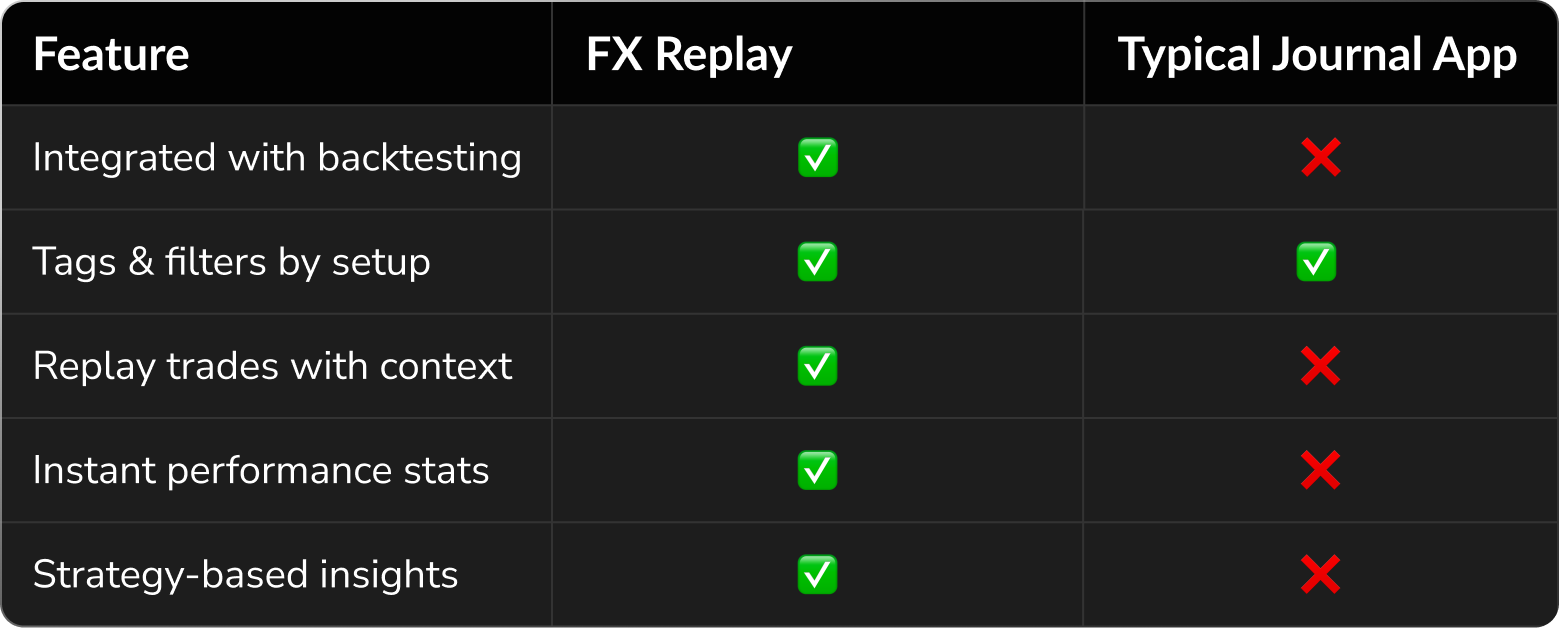The #1 Habit of Consistent Traders: Journaling

The difference between amateurs and professionals?
Professionals journal.
They don’t just take trades—they track them, review them, and learn from them.
Every. Single. Time.
This isn’t about writing down how you felt. It’s about understanding your process and identifying what’s actually working—and what’s not.
Inside FX Replay, journaling isn’t an extra step.
It’s built right into your flow. You replay, tag, review, and learn. Fast.
This one habit—done right—is the fastest way to go from random results to repeatable wins.
What Is Trade Journaling (Really)?
Forget the notebook and vague notes.
Real journaling is a structured review of your trading activity. It tracks data like:
- Entry/exit reasons
- Trade outcome (win/loss/R-multiple)
- Risk size
- Setup type
- Time of day
- Adherence to your trading plan
- Emotional state (optional, but powerful)
FX Replay turns this into a systematic, searchable, filterable process.
You can review a single trade—or zoom out to spot patterns over hundreds.
Why Most Traders Skip It (and Why That’s a Huge Mistake)
Let’s be honest: journaling sounds boring.
When you’re done trading, the last thing you want to do is dig through screenshots and type out notes.
But skipping this step is why most traders stay stuck.
They repeat the same mistakes without realizing it. They can't see patterns. They don’t know if their strategy actually works—or if they just got lucky.
Journaling is what turns screen time into skill.
And FX Replay makes it frictionless.
How FX Replay Makes Journaling Stupid-Simple
Here’s how journaling works inside FX Replay:
1. Simulate the Session
Replay any market day using real data. Execute your strategy, take your trades, and manage risk.
2. Tag and Log as You Go
With every trade, you can tag:
- Setup name
- Market condition
- Confidence level
- Risk amount
- Entry/exit reason
It takes 10 seconds. No switching tabs. No spreadsheet needed.
3. Auto-Generated Trade Logs
As soon as you're done, FX Replay gives you a full breakdown:
- Trade-by-trade performance
- Win/loss stats
- Average R
- Time-based performance (e.g., how you do in the first hour vs. second)
- Execution timing (early/late/perfect)
4. Spot Patterns Instantly
Filter by setup. Sort by session. Look for patterns like:
- Are you winning more in trending or ranging markets?
- Which setups give you the best R-multiple?
- Are your losses clustered around a specific time of day?
This is where consistency starts—with real, measurable feedback.
Real Consistency = Consistent Behavior
Most traders think they need better signals.
What they actually need is better behavior tracking.
That’s where journaling becomes your secret weapon. It helps answer questions like:
- Am I following my plan?
- Am I managing risk correctly?
- Which setups am I overtrading?
- What happens when I trade outside my system?
You don’t need more indicators.
You need data on your own decisions.
Journaling Isn’t Just for Review—It’s for Repetition
Here’s the edge that most traders miss:
You don’t just journal to remember. You journal to repeat.
When you log a trade, tag it, and review it later, you’re encoding your best decisions.
You’re creating a blueprint you can follow again and again.
Over time, that blueprint becomes muscle memory.
That’s how consistency is built—through clear feedback loops and deliberate reps.
Taylor’s Case: From Guessing to Data-Driven
Before journaling, Taylor was like most traders:
- Some good trades, some bad—no clue why
- Chased trades that “felt right” but didn’t match his plan
- Had no idea what setups actually made money
Once he started journaling every session in FX Replay, things changed:
- He identified that 80% of his profits came from just two setups
- He found he was losing most during low-volume lunchtime trades
- He stopped trading outside his plan—because the data told him not to
Within six weeks, Taylor was more confident, more selective, and more profitable.
Not because he found a “better” strategy—because he finally understood his own.
The Feedback Loop You Can’t Trade Without
Here’s what journaling inside FX Replay gives you:

This is the kind of feedback loop you don’t get in live markets—because the data isn’t structured.
In FX Replay, it is.
Don’t Just Track Wins. Track Mistakes.
Your losing trades are more valuable than you think—if you know how to study them.
FX Replay’s journaling lets you dig into:
- Why you entered
- What you missed
- What rule you broke
- What the better decision was
Mistakes are lessons.
But only if you track them.
Otherwise, you’re just bleeding slowly and calling it “learning.”
The Mindset Shift: From Emotional to Analytical
Traders who journal think differently.
They don’t say, “The market was tough today.”
They say, “I took two setups outside my plan, and both lost. That’s on me.”
That shift—from blaming the market to owning your process—is what builds mastery.
And the only way to get there is through honest, structured review.
What Makes FX Replay Journaling Different
There are plenty of journals out there. Here’s why FX Replay’s stands out:

It’s not just a notebook. It’s a performance engine.
Who Should Be Journaling
New Traders:
Build habits from day one. Learn what works and what doesn’t fast.
Intermediate Traders:
Spot hidden leaks. Refine your setups. Filter out bad behavior.
Experienced Traders:
Tighten execution. Validate new strategies. Scale with data-backed confidence.
If you’re serious about trading as a skill—not a gamble—journaling isn’t optional.
It’s mandatory.
Final Word: You’re Only as Good as Your Last Review
You can’t fix what you don’t track.
Journaling is the one habit that ties your strategy, execution, and mindset together.
Without it, you’re guessing.
With it, you’re building real, repeatable consistency—on purpose.
FX Replay gives you the tools to journal smarter, not harder.
Everything is in one place. Fast. Fluid. Built for real growth.
So ask yourself: Are you trading to feel good—or to get good?
Start journaling. Review every session.
Turn insights into execution—and execution into consistency.
Yes. The more consistent your journaling, the faster you’ll see patterns and areas for improvement.
Absolutely. You can tag every trade and filter them by setup, date, outcome, or session.
Both. You log trade context manually, but performance data and stats are generated automatically.
It creates structure. When you know you’re going to review your trades, you’re less likely to take impulsive ones.
Yes. FX Replay saves all your session data so you can review, compare, and track growth over time.






















